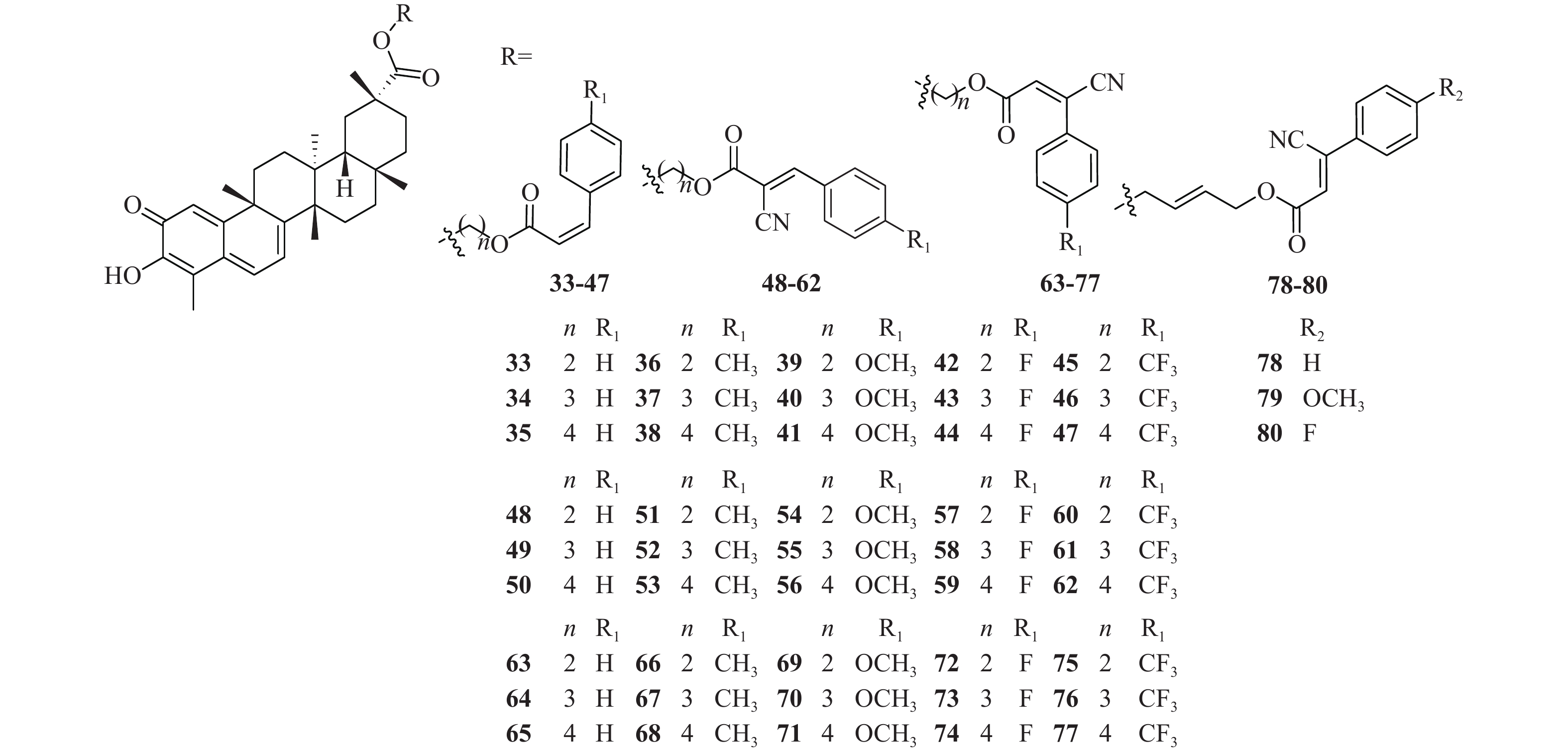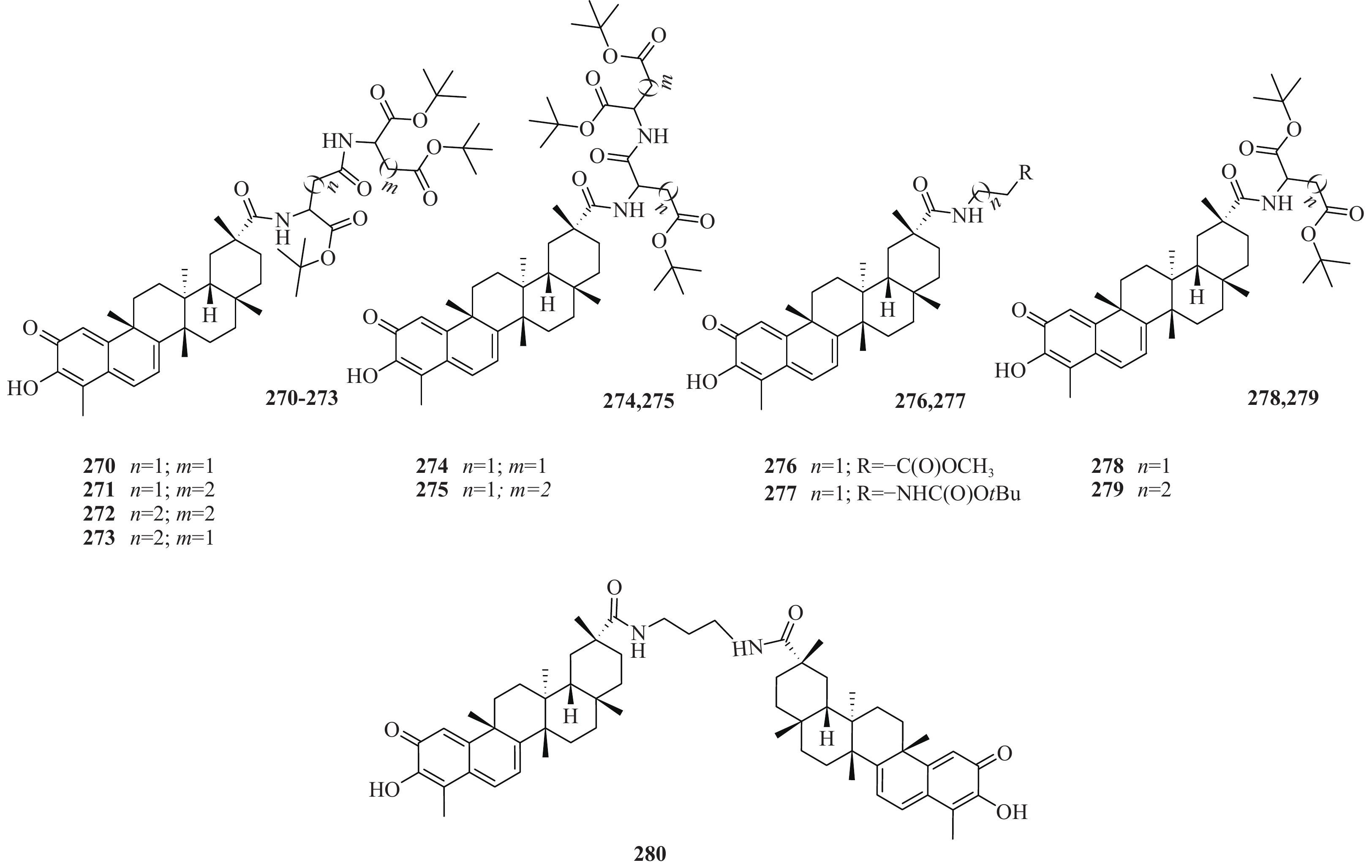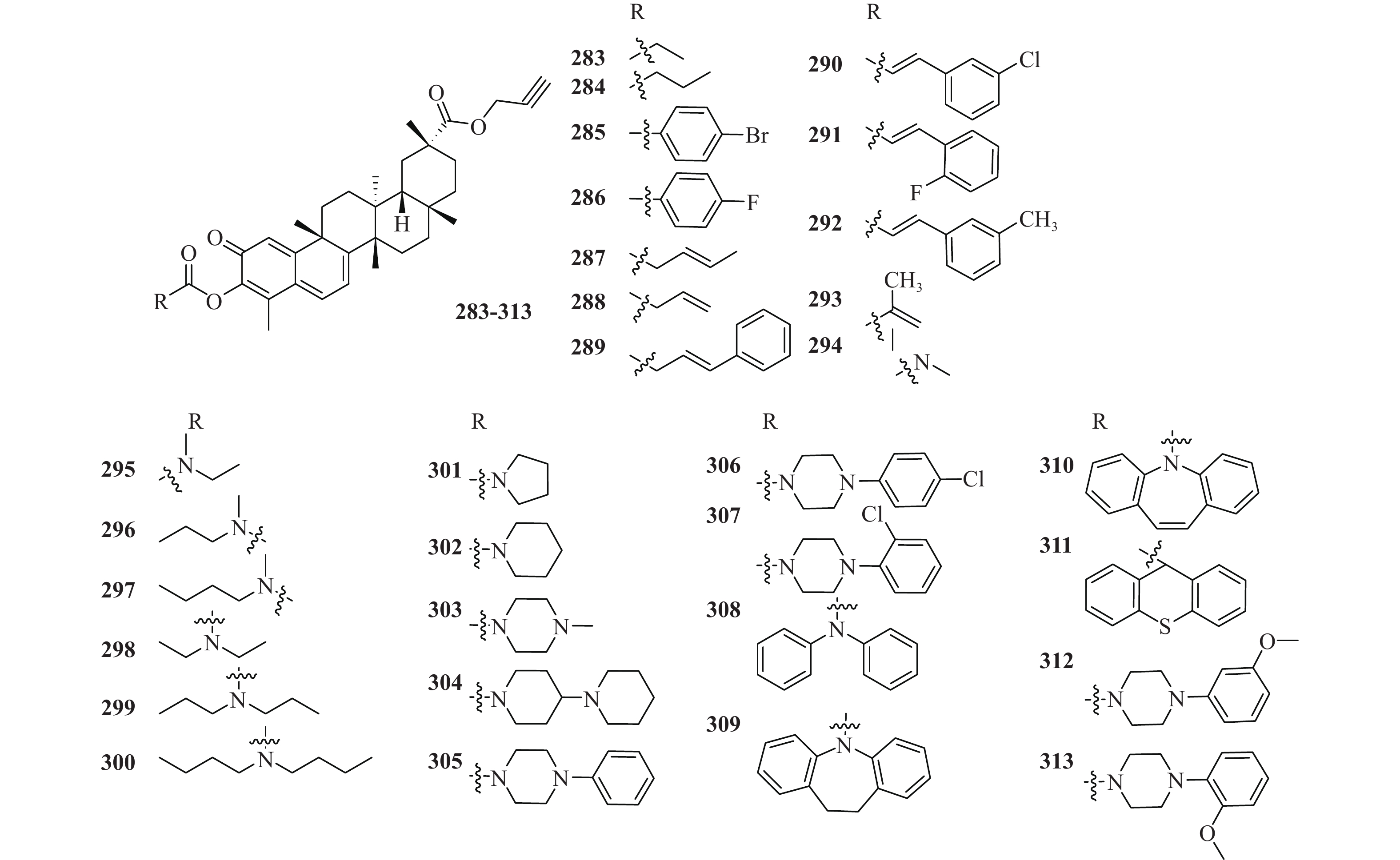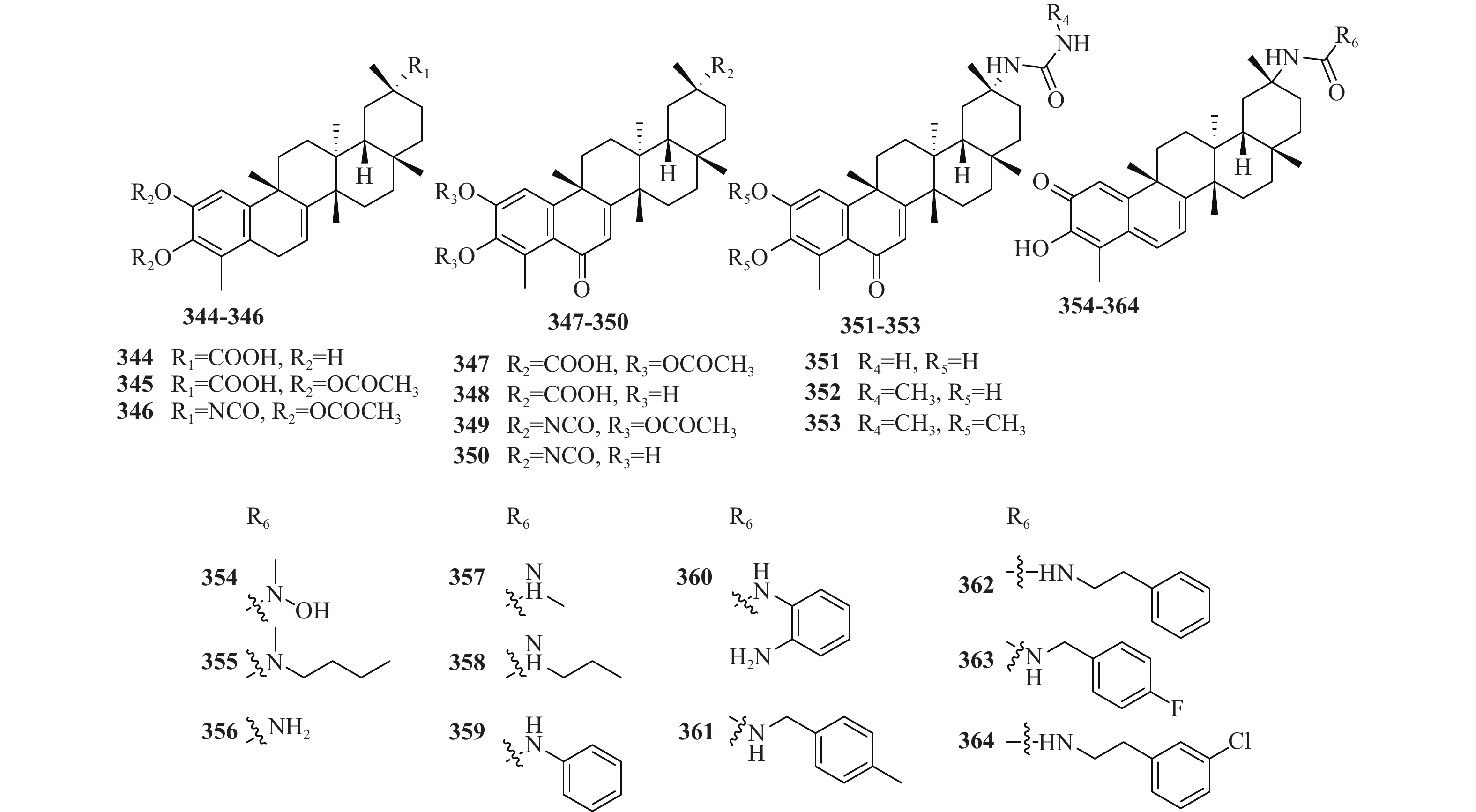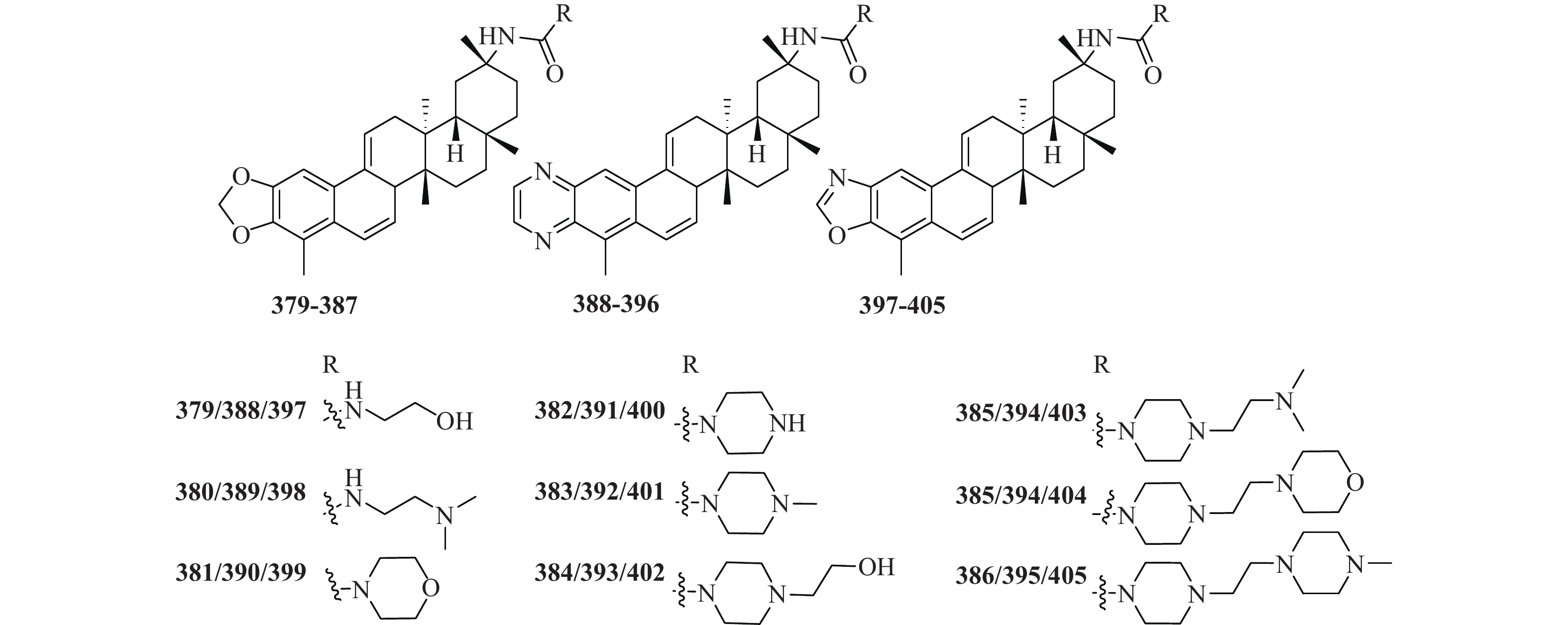Progress of research on celastrol derivatives as anti-tumor agents
-
摘要:
雷公藤红素是从中药雷公藤Tripterygium wilfordii Hook.f.根皮中分离得到的五环三萜类化合物,可抑制多种恶性肿瘤的生长,但也存在毒性大、水溶性差、靶向性欠佳等缺陷。因此,对其进行结构修饰是近年来的研究热点。已报道的雷公藤红素结构修饰主要集中在C-20-COOH及AB环的C-2、C-3、C-6位或多位点同时优化。本文主要依据不同的修饰位点、修饰目的(提高Hsp90-Cdc37 PPI抑制作用等)和修饰手段(基于骈和原理和特定靶点等),综述近年来雷公藤红素抗肿瘤类衍生物的研究进展。此外,还简要讨论了衍生物的抗肿瘤活性、作用机制和构效关系,以期能够为发现新的高效、低毒、选择性强的CEL衍生物提供理论指导。
Abstract:Celastrol, a pentacyclic triterpenoid compound derived from the root of Chinese herb Tripterygium wilfordii Hook.f.,can inhibit the growth of various types of malignant tumors. However, it still has some limitations, including high toxicity, poor water solubility, and low targeting efficiency. Therefore, structural modification of celastrol has become a research hotspot in recent years. The structural modifications of celstrol reported have focused on C-20-COOH and C-2, C-3, C-6 or multiple sites of AB ring. This review provides an overview of the research progress of anti-tumor celastrol derivatives in recent years according to different structural modification sites and purposes, such as enhancing the inhibitory effect on the Hsp90-Cdc37 protein-protein interaction, and modification methods, including principles of parallelism and targeting specific sites. In addition, it briefly discusses the antitumor activity, mechanism of action, and structure-activity relationship of these derivatives, aiming to provide theoretical guidance for the discovery of new celastrol derivatives with high efficiency, low toxicity, and strong selectivity.
-
Keywords:
- celastrol /
- anti-tumor /
- structural modification /
- structure activity relationship
-
雷公藤红素(celastrol,CEL)是从中药卫矛科植物雷公藤Tripterygium wilfordii Hook. f.的根皮中分离出来的一种主要活性成分,属于木栓烷型五环三萜类化合物,分子中含有高度共轭的醌甲基。研究表明,CEL可以抑制多种恶性肿瘤的生长,如血液系统[1−3]、泌尿生殖系统[4−6]、消化系统[7−9]及呼吸系统肿瘤[10−12]等。CEL的抗肿瘤机制主要有[13−14]:诱导肿瘤细胞凋亡、阻滞细胞周期、抑制肿瘤细胞侵袭、迁移及新血管的生成等。尽管CEL具有独特的结构骨架和显著的抗肿瘤活性,但也存在毒性大、水溶性差和靶向性欠佳等缺陷。因此,对其进行结构修饰以获得成药性更佳的抗肿瘤衍生物是近年来的研究热点。
目前针对CEL的结构修饰主要集中在C-20-COOH和AB环的C-2、C-3及C-6位等。本文综述近年来CEL抗肿瘤类衍生物的研究进展。
1. C-20位羧基的结构修饰及构效关系
1.1 基于提高Hsp90-Cdc37 PPI抑制作用的结构修饰
越来越多的研究表明,CEL通过抑制热休克蛋白90(heat shock protein 90, Hsp90)和细胞分裂周期蛋白37(cell division cycle protein 37, Cdc37)之间的蛋白-蛋白相互作用(protein-protein interaction, PPI)发挥抗肿瘤活性[15−16]。然而,CEL的PPI抑制作用强度尚有待提高。
笔者所在课题组基于Hsp90-Cdc37复合物晶体结构,采用计算机辅助药物设计,对CEL进行了较系统的结构修饰研究,以提高衍生物对Hsp90-Cdc37 PPI的抑制作用,进一步提高其抗肿瘤活性。近5年,本课题组先后在CEL的C-20-COOH上通过酯键或酰胺键以各种连接链分别引入(异)阿魏酸(酯)[17]、肉桂酸及其衍生物[18]、三氮唑[19]、咪唑[20]等,共合成约135个化合物(图1−图4)。体外活性筛选发现,大多数C-20-COOH衍生物对多种肿瘤细胞表现出优于CEL的活性,其中化合物23、72、86和126分别是几类衍生物中活性最强的化合物(IC50 = 0.15~0.54 μmol/L)。构效关系(structure-activity relationship, SAR)分析表明:C-20-COOH引入具有吸电子特性的芳杂环(如咪唑和三氮唑)可能会增强CEL与SH的结合,进而影响化合物与靶蛋白的结合;且当苯环或芳杂环结构中含有吸电子基团时,抗增殖活性明显增强。此外,连接臂的长度和类型也会影响衍生物的活性,研究表明,长度为2~4个碳的饱和直链烷基链较佳。作用机制研究表明,化合物23、72、86和126以不同的方式作用于Hsp90或/和Cdc37,抑制Hsp90-Cdc37 PPI的能力明显优于母体化合物CEL,并可诱导Hsp90的诸多客户蛋白(如p-Akt、CDK4等)失调。
此外,Jiang等[21]在C-20-COOH分别通过酯、酰胺键引入极性基团得到衍生物136~158(图5),结果显示,化合物155抑制Hsp90-Cdc37 PPI的活性最强,且对Pan-1细胞的生长抑制作用优于CEL(IC50:1.12 vs 2.48 μmol/L)。Hu等[22]设计合成了约15个衍生物159~174(图6)。其中,化合物167表现出最强的PPI抑制活性,且其体外抗增殖活性也最强(MDA-MB-231:IC50 = 0.2 μmol/L),比CEL提高约4.5倍(IC50 = 0.9 μmol/L)。上述研究成果为Hsp90-Cdc37 PPI抑制剂的研究提供了科学依据。
1.2 基于药效团骈合原理设计的CEL杂合衍生物
杂合策略广泛应用于先导化合物的结构修饰。基于此,研究人员将CEL(C-20-COOH)与具有抗肿瘤活性的药效团连接起来形成杂合物,以期获得具有更高抗肿瘤活性的衍生物。
研究表明,低浓度的NO可以促进肿瘤细胞生长,高浓度NO则不利于肿瘤生长而具有抗肿瘤作用[23]。NO供体是一类在体内经酶或非酶作用释放NO的化合物。本课题组Li等[24]在C-20位羧基上通过酯和酰胺键分别引入呋咱氮氧化物类和硝酸酯类NO供体,设计合成约11个目标化合物(图7)。其中,化合物183对A549、MCF-7、HOS和HepG2细胞均显示出较强的抑制活性(IC50 = 0.48~1.41 μmol/L),明显优于CEL。初步的SAR分析发现:呋咱氮氧化物类NO供体型衍生物比硝酸酯类的活性普遍更高。这与之前的研究结果一致,即在先导物中引入能释放高浓度NO的呋咱氮氧化物类NO供体更有利于提高目标物的抗肿瘤活性[25]。
噻唑烷二酮能与靶蛋白形成氢键,表现出多种抗肿瘤活性。Fu等[26]以乙酰哌嗪为连接臂,在C-20羧基上引入噻唑烷二酮,得到20个衍生物(图8)。结果显示,大部分化合物(IC50 = 0.08~1.06 μmol/L)对A549的抑制活性优于CEL。这表明TZD部分的烯酮结构有助于增强细胞毒性。其中,化合物189作用最强(IC50 = 0.08 μmol/L),且肿瘤细胞选择性高(selectivity index, SI= 37.75)。
研究显示,CEL可以抑制缺氧诱导因子-1α(hypoxia inducible factor-1α, HIF-1α)的表达[27],但作用不强。因此,Shang等[28]采用骈合原理在C-20羧基分别引入不同类型的杂环,合成了24个衍生物(图9),以期通过协同作用提高HIF-1α抑制作用。研究表明,化合物208、213、220和228(IC50:0.05~0.16 μmol/L)的HIF-1α抑制活性强于CEL(IC50 = 0.25 μmol/L)。此外,引入喹啉的衍生物220的水溶性提高了约1.36倍。这表明靶向HIF-1α及其信号通路可能在一定程度上改善CEL的成药性。
此前,有报道称CEL具有抑制卵巢癌细胞的干细胞(cancer stem cells,CSCs)特性[29]。因此,Li等[30]将CEL和肉桂酰胺相连,获得17个衍生物(图10)。其中含有3,4,5-三甲氧基取代的衍生物243对卵巢癌细胞SKOV3、OVCAR3和A2780表现出较强抗增殖活性(IC50 = 0.62~0.68 μmol/L)。进一步研究发现,化合物243不仅有效抑制CSCs集落形成,还降低CSCs生物标志物的比率。这表明化合物243能够抑制卵巢癌CSCs生长。
研究发现,CEL能提升胃癌细胞内活性氧(reactive oxygen species , ROS)水平[31]。基于此,本课题组Lei等[32]将ROS诱导剂片段吡唑及其类似物引入CEL的C-20位羧基,合成24个衍生物(图11)。其中,化合物266显著升高肿瘤细胞和组织中的ROS水平,且对BGC-823细胞表现出最强的活性(IC50 = 0.21 μmol/L)。分析SAR可知,当吡唑的C-4位被乙酯基取代且用3个碳原子的饱和烷基链作为连接臂时,可显著增强CEL-吡唑衍生物的活性。这说明通过合适的连接臂引入吡唑类片段可以通过提升ROS增加CEL的抗增殖活性。
据报道,CEL可以通过抑制P-糖蛋白(P-glycoprotein, P-gp)和肌内质网(sarco-endoplasmic reticulum, SR)Ca2+转运ATP酶(SERCA)逆转多药耐药[33]。基于此,Coghi等[34]设计合成了双靶向P-gp和SERCA的11个CEL酰胺衍生物和多肽衍生物(图12)。其中,化合物274对HepAD38细胞的生长表现出最强的抑制能力(IC50 = 0.44 μmol/L),且具有较高的肿瘤细胞选择性(SI = 12.75)。作用机制研究证明了化合物274是P-gp和SERCA的有效双靶点抑制剂。
1.3 基于特定靶点设计的CEL衍生物
针对CEL发挥抗肿瘤活性的分子靶标不够清晰的问题,Xu等[35]运用多种技术手段发现CEL对过氧化氢氧化还原酶1(peroxiredoxin, Prdx1)的抑制作用最强(IC50 = 290 nmol/L)。深入研究显示,CEL与Prdx1蛋白的第173位半胱氨酸共价结合。在此基础上,他们设计合成了衍生物281和282(图13),其中化合物281选择性与Prdx家族中Prdx1结合(Prdx1:IC50 = 210 nmol/L,Prdx2~6:IC50 > 100 μmol/L)。体内实验也证实了Prdx1是化合物281发挥抗肿瘤作用的靶标,且281的体内安全性明显优于CEL。
2. C-3羟基或/和C-20羧基的结构修饰及构效关系
CEL的C-3羟基可以与半胱天冬酶 3(caspase 3)相互作用,从而导致caspase 3过度激活,这可能是CEL选择性较差的原因之一。因此,在C-3上羟基引入可以削弱相互作用的基团可能是减少毒性的有效策略。基于此,Hu等[22]以前期发现的167[22]为先导化合物,将其C-3羟基衍生化成酯或取代氨基甲酸酯,得到31个化合物(图14)。结果表明,其肿瘤细胞选择性显著提升,其中化合物304的选择性(SI = 15.4)分别比CEL和167提高了约19(SI = 0.8)和3.85(SI = 4.0)倍。此外,表面等离子体共振实验结果也表明,化合物304与caspase-3之间的结合亲和力较化合物167减弱(KD:3.8 vs 0.9 μmol/L)。综上所述,在C-3羟基上引入具有较大位阻的刚性氨基甲酸酯基团可以减少CEL衍生物对caspase 3的活化作用,从而降低毒性。
Feng等[36]在C-3羟基和C-20羧基上分别引入1,2,3-三氮唑及其衍生物,合成两类衍生物314~328和329~343(图15)。体外活性结果显示,C-20衍生物329~343较C-3衍生物314~328表现出更强的抗增殖活性。其中,化合物337活性最强(U251:IC50 = 0.94 μmol/L),比CEL(U251:IC50 = 4.43 μmol/L)高约4.7倍。
3. 多位点结构修饰的衍生物及构效关系
Figueiredo等[37]对C-2、C-3、C-6和C-20进行修饰,设计了一系列多位点优化的衍生物(图16),旨在探究醌甲基是否为抗肿瘤作用的关键基团。研究结果显示,2,3-取代的化合物344~346表现出较低的抗肿瘤活性;其次,2,3-取代且C-6为羰基的化合物347~353的抗增殖活性急剧下降(IC50 > 15 μmol/L),此结果说明醌甲基是抗肿瘤活性的必需基团。而在C-20羧基上引入尿素得到的化合物354~364,显著抑制肿瘤细胞的生长,其中化合物355的活性最强(MIA PaCa-2:IC50 = 0.31 μmol/L)。
Li等[38]在前期工作基础上,又设计合成了14个新的抗卵巢癌CSC的衍生物365~378(图17)。C-20具有相同取代哌嗪基团但保留AB环醌甲基的化合物365~371比372~378(A/B环被修饰)表现出更强的细胞生长抑制能力。该研究进一步证明AB环醌甲基的重要性。机制研究表明,化合物367增强的抗卵巢癌CSCs的能力可能与增加细胞内ROS水平和抑制STAT3信号通路有关。
Feng等[39]运用骨架迁移策略将AB环骈合1,3-二噁茂环、吡嗪环和噁唑环,并将C-20羧基替换为各种不同取代的脲基,合成了3个系列共27个衍生物(图18),并评估了所有目标化合物的体外抗增殖活性。结果显示:噁唑类衍生物397~405(IC50 = 1.28~10.00 μmol/L)表现出比吡嗪类388~396(IC50 = 1.66~11.65 μmol/L)和二噁茂类379~387(IC50 = 1.31~10.28 μmol/L)更有效的抗增殖活性。特别是化合物401,对Bel7402细胞的抑制作用最强(IC50 = 1.28 μmol/L)。进一步分析C-20上不同取代基对衍生物活性的影响,可以得出结论:引入二甲氨基-乙基、哌嗪基或在哌嗪基的N上引入不同的取代基能不同程度地提高衍生物的活性。这些发现为设计开发更有效的多位点修饰的抗肿瘤CEL衍生物提供了参考。
4. 总结与展望
CEL是具有显著抗肿瘤活性的明星天然产物之一。研究发现,CEL调节癌症进展过程中的各重要阶段,如增殖、血管生成、转移等。然而,严重的不良反应使CEL的临床应用受限。因此,许多研究者对CEL的结构进行优化以提高其成药性。本文综述了近年来合成的抗肿瘤类CEL衍生物,大部分是在CEL的C-20-COOH上进行的修饰。与CEL相比,大多数衍生物抗肿瘤活性增强,部分化合物表现出降低的毒性和改善的水溶性。如前所述,笔者所在课题组已对CEL进行了较深入的结构修饰研究[17−20,24,32],主要通过杂合策略在其C-20-COOH上引入各种药效基团,提高了衍生物抑制Hsp90-Cdc37 PPI或诱导肿瘤细胞内ROS生成的能力,部分化合物的抗肿瘤活性显著增强。现阶段,课题组仍继续致力于CEL的结构修饰研究,以期改善其选择性、降低毒性。随着越来越多先进技术和理念的出现,必将产生更多样的CEL衍生物,希望本文能够为发现新的高效、低毒、选择性强的CEL衍生物提供理论指导。
-
[1] Xu XM, Kang D, Zhu XY, et al. Effect of celastrol based on IRAK4/ERK/p38 signaling pathway on proliferation and apoptosis of multiple myeloma cells[J]. J Exp Hematol (中国实验血液学杂志), 2022, 30(1): 175-182. [2] Zhong YL, Xu GJ, Huang S, et al. Celastrol induce apoptosis of human multiple myeloma cells involving inhibition of proteasome activity[J]. Eur J Pharmacol, 2019, 853: 184-192. doi: 10.1016/j.ejphar.2019.03.036
[3] Zhang XL, Li AP, Huan F, et al. Effects of celastrol on the proliferation and apoptosis of human leukemia cells HL-60 and Jurkat[J]. J China Pharm Univ (中国药科大学学报), 2015, 46(1): 89-93. [4] Wang X, Liu Q, Wu SS, et al. Identifying the effect of celastrol against ovarian cancer with network pharmacology and in vitro experiments[J]. Front Pharmacol, 2022, 13: 739478. doi: 10.3389/fphar.2022.739478
[5] Arisan ED, Rencuzogullari O, Coban M, et al. The role of the PI3K/AKT/mTOR signaling axis in the decision of the celastrol-induced cell death mechanism related to the lipid regulatory pathway in prostate cancer cells[J]. Phytochem Lett, 2020, 39: 73-83. doi: 10.1016/j.phytol.2020.06.007
[6] Tan QL, Liu ZQ, Gao XB, et al. Celastrol recruits UBE3A to recognize and degrade the DNA binding domain of steroid receptors[J]. Oncogene, 2022, 41(42): 4754-4767. doi: 10.1038/s41388-022-02467-8
[7] Zhan DM, Ni TY, Wang HB, et al. Celastrol inhibits the proliferation and decreases drug resistance of cisplatin- resistant gastric cancer SGC7901/DDP cells[J]. Anticancer Agents Med Chem, 2022, 22(2): 270-279. doi: 10.2174/1871520621666210528144006
[8] Chen GE, Zhu XY, Li JQ, et al. Celastrol inhibits lung cancer growth by triggering histone acetylation and acting synergically with HDAC inhibitors[J]. Pharmacol Res, 2022, 185: 106487. doi: 10.1016/j.phrs.2022.106487
[9] Zhang WX, Wu ZM, Qi HJ, et al. Celastrol upregulated ATG7 triggers autophagy via targeting Nur77 in colorectal cancer[J]. Phytomedicine, 2022, 104: 154280. doi: 10.1016/j.phymed.2022.154280
[10] Dai CH, Zhu LR, Wang Y, et al. Celastrol acts synergistically with afatinib to suppress non-small cell lung cancer cell proliferation by inducing paraptosis[J]. J Cell Physiol, 2021, 236(6): 4538-4554. doi: 10.1002/jcp.30172
[11] Liu M, Fan YM, Li DY, et al. Ferroptosis inducer erastin sensitizes NSCLC cells to celastrol through activation of the ROS-mitochondrial fission-mitophagy axis[J]. Mol Oncol, 2021, 15(8): 2084-2105. doi: 10.1002/1878-0261.12936
[12] Zhao ZC, Wang YM, Gong YY, et al. Celastrol elicits antitumor effects by inhibiting the STAT3 pathway through ROS accumulation in non-small cell lung cancer[J]. J Transl Med, 2022, 20(1): 525. doi: 10.1186/s12967-022-03741-9
[13] Lim HY, Ong PS, Wang LZ, et al. Celastrol in cancer therapy: recent developments, challenges and prospects[J]. Cancer Lett, 2021, 521: 252-267. doi: 10.1016/j.canlet.2021.08.030
[14] Lu Y, Liu Y, Zhou JW, et al. Biosynthesis, total synthesis, structural modifications, bioactivity, and mechanism of action of the quinone-methide triterpenoid celastrol[J]. Med Res Rev, 2021, 41(2): 1022-1060. doi: 10.1002/med.21751
[15] Sreeramulu S, Gande SL, Göbel M, et al. Molecular mechanism of inhibition of the human protein complex Hsp90-Cdc37, a kinome chaperone-cochaperone, by triterpene celastrol[J]. Angew Chem Int Ed, 2009, 48(32): 5853-5855. doi: 10.1002/anie.200900929
[16] Zhang T, Hamza A, Cao XH, et al. A novel Hsp90 inhibitor to disrupt Hsp90/Cdc37 complex against pancreatic cancer cells[J]. Mol Cancer Ther, 2008, 7(1): 162-170. doi: 10.1158/1535-7163.MCT-07-0484
[17] Xu MY, Li N, Zhao ZH, et al. Design, synthesis and antitumor evaluation of novel celastrol derivatives[J]. Eur J Med Chem, 2019, 174: 265-276. doi: 10.1016/j.ejmech.2019.04.050
[18] Li N, Xu MY, Wang B, et al. Discovery of novel celastrol derivatives as Hsp90-Cdc37 interaction disruptors with antitumor activity[J]. J Med Chem, 2019, 62(23): 10798-10815. doi: 10.1021/acs.jmedchem.9b01290
[19] Li N, Chen C, Zhu HT, et al. Discovery of novel celastrol-triazole derivatives with Hsp90-Cdc37 disruption to induce tumor cell apoptosis[J]. Bioorg Chem, 2021, 111: 104867. doi: 10.1016/j.bioorg.2021.104867
[20] Li N, Xu MY, Zhang LL, et al. Discovery of novel celastrol-imidazole derivatives with anticancer activity in vitro and in vivo[J]. J Med Chem, 2022, 65(6): 4578-4589. doi: 10.1021/acs.jmedchem.1c01293
[21] Jiang F, Wang HJ, Bao QC, et al. Optimization and biological evaluation of celastrol derivatives as Hsp90-Cdc37 interaction disruptors with improved druglike properties[J]. Bioorg Med Chem, 2016, 24(21): 5431-5439. doi: 10.1016/j.bmc.2016.08.070
[22] Hu XL, He QW, Long H, et al. Synthesis and biological evaluation of celastrol derivatives with improved cytotoxic selectivity and antitumor activities[J]. J Nat Prod, 2021, 84(7): 1954-1966. doi: 10.1021/acs.jnatprod.1c00262
[23] Fei Y, Zhang YH, Huang ZJ. Advance in selective/targeted nitric oxide releasing strategies[J]. Prog Pharm Sci(药学进展), 2019, 43(11): 804-816. [24] Li N, Xu MY, Bao N, et al. Discovery of novel NO-releasing celastrol derivatives with Hsp90 inhibition and cytotoxic activities[J]. Eur J Med Chem, 2018, 160: 1-8. doi: 10.1016/j.ejmech.2018.10.013
[25] Huang W, Zhang J, Luo L, et al. Nitric oxide and tumors: from small-molecule donor to combination therapy[J]. ACS Biomater Sci Eng, 2023, 9(1): 139-152. doi: 10.1021/acsbiomaterials.2c01247
[26] Fu XF, Mao Q, Zhang B, et al. Thiazolidinedione-based structure modification of celastrol provides thiazolidinedione-conjugated derivatives as potent agents against non-small-cell lung cancer cells through a mitochondria-mediated apoptotic pathway[J]. J Nat Prod, 2022, 85(4): 1147-1156. doi: 10.1021/acs.jnatprod.2c00104
[27] Huang LL, Zhang ZF, Zhang S, et al. Inhibitory action of celastrol on hypoxia-mediated angiogenesis and metastasis via the HIF-1α pathway[J]. Int J Mol Med, 2011, 27(3): 407-415.
[28] Shang FF, Wang JY, Xu Q, et al. Design, synthesis of novel celastrol derivatives and study on their antitumor growth through HIF-1α pathway[J]. Eur J Med Chem, 2021, 220: 113474. doi: 10.1016/j.ejmech.2021.113474
[29] Li XJ, Wang HM, Ding J, et al. Celastrol strongly inhibits proliferation, migration and cancer stem cell properties through suppression of Pin1 in ovarian cancer cells[J]. Eur J Pharmacol, 2019, 842: 146-156. doi: 10.1016/j.ejphar.2018.10.043
[30] Li XJ, Ding J, Li N, et al. Synthesis and biological evaluation of celastrol derivatives as anti-ovarian cancer stem cell agents[J]. Eur J Med Chem, 2019, 179: 667-679. doi: 10.1016/j.ejmech.2019.06.086
[31] Chen X, Zhao Y, Luo W, et al. Celastrol induces ROS-mediated apoptosis via directly targeting peroxiredoxin-2 in gastric cancer cells[J]. Theranostics, 2020, 10(22): 10290-10308. doi: 10.7150/thno.46728
[32] Lei ZC, Li N, Yu NR, et al. Design and synthesis of novel celastrol derivatives as potential anticancer agents against gastric cancer cells[J]. J Nat Prod, 2022, 85(5): 1282-1293. doi: 10.1021/acs.jnatprod.1c01236
[33] Xu SW, Law BYK, Qu SLQ, et al. SERCA and P-glycoprotein inhibition and ATP depletion are necessary for celastrol-induced autophagic cell death and collateral sensitivity in multidrug-resistant tumor cells[J]. Pharmacol Res, 2020, 153: 104660. doi: 10.1016/j.phrs.2020.104660
[34] Coghi P, Ng JPL, Kadioglu O, et al. Synthesis, computational docking and biological evaluation of celastrol derivatives as dual inhibitors of SERCA and P-glycoprotein in cancer therapy[J]. Eur J Med Chem, 2021, 224: 113676. doi: 10.1016/j.ejmech.2021.113676
[35] Xu H, Zhao HF, Ding CY, et al. Celastrol suppresses colorectal cancer via covalent targeting peroxiredoxin 1[J]. Signal Transduct Target Ther, 2023, 8(1): 51. doi: 10.1038/s41392-022-01231-4
[36] Feng Y, Wang WB, Zhang Y, et al. Synthesis and biological evaluation of celastrol derivatives as potential anti-glioma agents by activating RIP1/RIP3/MLKL pathway to induce necroptosis[J]. Eur J Med Chem, 2022, 229: 114070. doi: 10.1016/j.ejmech.2021.114070
[37] Figueiredo SAC, Salvador JAR, Cortés R, et al. Novel celastrol derivatives with improved selectivity and enhanced antitumour activity: design, synthesis and biological evaluation[J]. Eur J Med Chem, 2017, 138: 422-437. doi: 10.1016/j.ejmech.2017.06.029
[38] Li N, Li CB, Zhang J, et al. Discovery of semisynthetic celastrol derivatives exhibiting potent anti-ovarian cancer stem cell activity and STAT3 inhibition[J]. Chem Biol Interact, 2022, 366: 110172. doi: 10.1016/j.cbi.2022.110172
[39] Feng Y, Zhang B, Lv JL, et al. Scaffold hopping of celastrol provides derivatives containing pepper ring, pyrazine and oxazole substructures as potent autophagy inducers against breast cancer cell line MCF-7[J]. Eur J Med Chem, 2022, 234: 114254. doi: 10.1016/j.ejmech.2022.114254




 下载:
下载:

